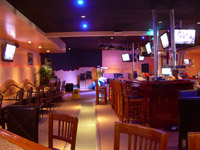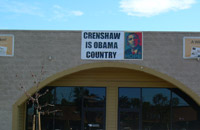A parking lot with more than 100 spaces at University High School was closed recently to make way for the construction of a new gym, but some students wish the school had waited until the summer to start building.
The West Los Angeles high school gym is located on a fault line, so the school is moving the structure from its current location on Westgate Avenue to Ohio Avenue on what was, until March, a student parking lot. There are two smaller parking lots off Barrington Avenue offering free and permit-less parking for those students who arrive early enough, but others still try parking on the streets.
“Fridays are horrible,” said senior Golmah Zarinkhou, who used to park on the streets near school. “One day I had to spend an hour-and-a-half looking for parking.”
Most streets near University High School have street cleaning on Friday, meaning students who leave their cars there between 10 a.m. and 12 p.m. that day could get tickets or worse.
“I do notice quite a few people get towed,” said one resident who lives across the street but preferred not to be identified.
A total of 2,218 students attend University High School, but parking is primarily an issue that affects some of the 483 seniors.
Parking regulations on the streets that surround University High School – including Barrington, Texas, Westgate and Ohio avenues – vary. On the school-side of Westgate Avenue, for example, only loading is permitted on school days between 6:30-9:00 a.m. and 1:30-4:00 p.m. The school-side parking lane on Texas Avenue is reserved for buses, but there is some mostly unrestricted parking on Barrington Avenue opposite the school.
The school-side of Barrington Avenue does not allow any parking from 8 a.m. to 5 p.m., but this restriction could be loosened. According to Mo Blorfroshan, a transportation engineer for the western district office of the Los Angeles Department of Transportation, changing that restriction on the school-side of the street would require a letter from the Los Angeles Unified School District requesting different parking regulations.
“We would have no problem with that,” said Blorfroshan.
After the LAUSD request letter is received, Blorfroshan explained it would take approximately 8-10 weeks to put the new regulations into effect and install new signs.
Changing street cleaning to weekends might also ease the parking situation at the high school. Alternately, a dirt lot once occupied by bungalows could be converted into a parking lot. These plans, the school’s student newspaper reports, are scheduled for construction in May. The newspaper said the lot, in its current state, is inadequate for students due to its “unsafe entrance gate, uneven ground and falling pinecones.”
Assistant principal Dan Blank declined to comment for this story.
Jim Nakabara, a 33-year teacher and the school’s athletic director, believes the issue is overstated.
“Once [people] get used to parking in a certain area, it’s a habit and they don’t want to break the habit,” he said.
Students’ reluctance to park elsewhere might also be related to the conditions under which they were told about the large parking lot’s closing. Zarinkhou said the school left notes on vehicles one Friday explaining the lot would be closed on Monday.
“Previous notice would have been definitely nice,” Zarinkhou said.
Some students and faculty wonder why construction could not have started in the summer, but with the school already behind the initially proposed construction schedule, high school officials might have wanted to expedite the construction process.
“I just think the district is playing it safe,” said Nakabara, who also attended University High School. “There is a fault they found when they were researching it a few years ago and they said in a major earthquake there’ll be less than a one percent chance of major damage to the building.”
Once the new gym is completed, the West Gym presently serving students can be demolished. On that space, tennis courts or a new parking lot might fit, Nakabara said. With demand for student parking far outstripping the supply of available spaces, the school might also introduce paid parking permits with the potential new lot. For now, though, students who drive to school can choose from the two lots on Barrington Avenue or try street parking.









.jpg) CRA/LA officials said regular committee meetings make more sense once the consulting stages have been completed. The agency responded to charges of not communicating with local CACs by noting its advertisements in local newspapers, stories in its newsletter and quarterly steering committee meetings that focus on the merger.
CRA/LA officials said regular committee meetings make more sense once the consulting stages have been completed. The agency responded to charges of not communicating with local CACs by noting its advertisements in local newspapers, stories in its newsletter and quarterly steering committee meetings that focus on the merger..jpg) Just a day after the Kingdom Day Parade celebrating Martin Luther King Jr.’s birthday marched within two blocks of the Crenshaw Square, Mama’s House soul food restaurant was open early to welcome those who wanted to celebrate Obama’s inauguration over grits and eggs.
Just a day after the Kingdom Day Parade celebrating Martin Luther King Jr.’s birthday marched within two blocks of the Crenshaw Square, Mama’s House soul food restaurant was open early to welcome those who wanted to celebrate Obama’s inauguration over grits and eggs. As an African-American woman, the night of the election was just overwhelming, so … to me it didn’t really matter that he said what he was gonna do or how he was gonna do it," she said.
As an African-American woman, the night of the election was just overwhelming, so … to me it didn’t really matter that he said what he was gonna do or how he was gonna do it," she said. "I like to listen or watch him," Reyes said, "but I didn’t have time this morning."
"I like to listen or watch him," Reyes said, "but I didn’t have time this morning."




